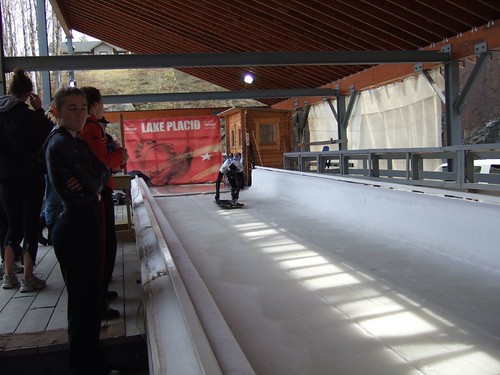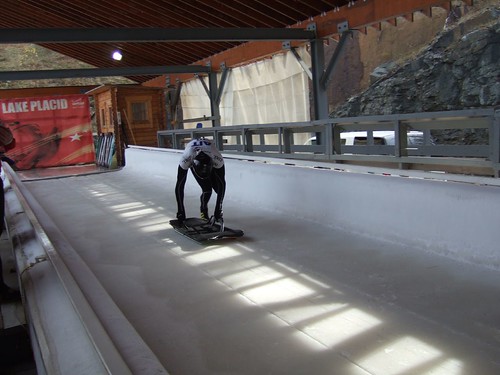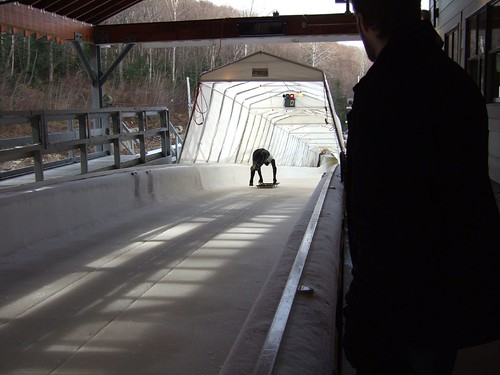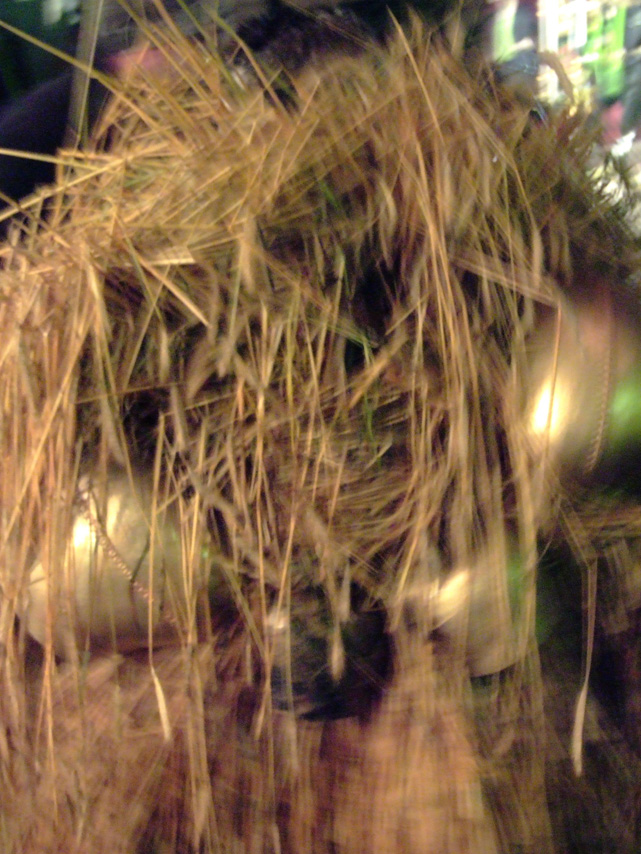Snow Patrol
 Ok, we were supposed to be doing a competition here in Altenberg but because it decided to snow so damn much the race has been cancelled.
Ok, we were supposed to be doing a competition here in Altenberg but because it decided to snow so damn much the race has been cancelled.I'll explain how racing works. There are official training runs that take place in the couple of days leading up to a race. There are supposed to be 6 training runs available of which you must successfully complete at least 3 to be able to do the competition. The reason for this is two-fold: It gives you a chance to re-familiarise yourself with the track if you haven't been on it recently, and it weeds out those that may not be able to handle the track safely when it has been specially prepared on race day and it is lightning fast.
The race itself consists of two heats. There is some seeding that takes place in a race draw that determines the order in which competitors go off in the first run. The fastest 25 from the first heat get to do a second heat in the order of slowest to fastest. For example, last week I was 21st in the first heat, which meant I went off 4th in the second heat. Your final time is the combination of your first heat and your second heat and this determines your final placing. It is obviously possible to gain or lose ranking during the second heat if you have a great second run, or if you mess it up.
Our race cancellation started off innocuously enough with a training session being cancelled. Then another. A last ditch proposal to have one training run on the morning of the race, then the race in the afternoon was further diminished to having one training run on the afternoon followed immediately by a one-run race. Finally it was all cancelled. Stupid snow.
Tyler and I made an expedition to the track office to collect our licences. On the way we saw complete chaos on the roads. Despite being an ass-crack t
 own, Altenberg lies on one of the major trucking routes between Germany and the Czech Republic. Steep roads, heavily laden articulated trucks and copious amounts of snow are a recipe for … some sort of weird disgusting disaster cake. Trucks being towed by special recovery trucks that must have more horsepower than a tugboat and more grip than a gorilla with glue on his hands. Trucks stuck on the side of the road cos they can’t get any further up the hill, even with chains on.
own, Altenberg lies on one of the major trucking routes between Germany and the Czech Republic. Steep roads, heavily laden articulated trucks and copious amounts of snow are a recipe for … some sort of weird disgusting disaster cake. Trucks being towed by special recovery trucks that must have more horsepower than a tugboat and more grip than a gorilla with glue on his hands. Trucks stuck on the side of the road cos they can’t get any further up the hill, even with chains on. We also nearly had some tree fall on our car, which required us to manually lift it out of the way. Apparently being cold gives you enormous tree lifting strength. Don’t ask.
We also nearly had some tree fall on our car, which required us to manually lift it out of the way. Apparently being cold gives you enormous tree lifting strength. Don’t ask. At this stage I'm not sure whether I’m annoyed or relieved. Altengberg is a love-hate track. It's mean and unforgiving to the bad slider. Sometimes it's mean and unforgiving to the good slider. You may recall how I recently said that on most tracks if you get on the sled and lie there like a sack of potatoes you'll get down without too much trouble, speed or injury. This is not one of those tracks.
There are two corners here that will make a serious, committed effort to fuck you up. The first is called Omega, most likely because it looks like an omega. It's a 180-degree left turn that likes to leave you high on the wall at the end of the corner. The corner has finished coming around at this stage so there is no pressure and it's not obliged to hold you up there. So it drops you out into the left wall, hard. Hard enough to bump you off the sled, or if you catch the beginning of the next corner it'll flip you over.
Omega is not nearly as tough as the other corner. It's called Kreisel. It's a standard name on most tracks for a corner that turns more than 180 degrees. This one in particular turns 360 degrees. What that means is that you're pinned to that wall as you hook around this huge corner that loops around right and curves back under itself. What makes it even better is that there is a long 60m straight leading into it so you've got plenty of speed when you come trucking into this corner. I remember the first time I saw it four years ago. We were doing a track walk with Andy Walser (Sled God who makes our sleds) and he summed up the corner nicely. "If you go in early, it's ok. If you go in late, you die". His English isn't great but he gets the point across.

Imagine a corner turning right. If you enter the corner on the left side it’s called getting in early. The resulting change of direction is smoother. If you enter it on the right side, it’s called getting in late and your change of direction will be very abrupt. If you enter Kreisel on the left you’ll experience a relatively gradual onset of pressure as the corner brings you around. If you go in late, all five G’s hit you in a split second, your head suddenly weighs five times as much as normal and you crack your jaw off the edge of your sled, or the track underneath, whichever is closer.
But that’s just the entry; the corner’s not finished with you yet. As the corner continues to come around, the pressure rises and falls. This makes the sled rise and fall so you get huge oscillations that you have to control as hard as you can. If you do it right you flatten out into 3 big waves. If you do it wrong you get a fourth wave that doesn’t just flip you, it gives you air time Michael Jordan would be proud of. I think pretty much everyone has flown out of Kreisel at some stage or another. I’ve put a video here so you can see what it looks like when it goes wrong. When it goes right it’s a great feeling and either way the remaining six corners are almost fun enough to make up for Omega and Kreisel.
On balance I’m probably just relieved, I didn’t actually need to do this race and there’s nothing to be gained from hurting myself on this track.
From here I’ve got a day or two off which are gonna be spent relaxing a bit with some of our American traveling companions. After that I’m heading to Konigssee for five days training before going home for Christmas on the 23rd December. I’m seriously looking forward to getting home. I’ve been away for two and a half months. It’s been fun and all but I’m not overly fond of German food or German beds. The former is too processed and the latter is too soft.









